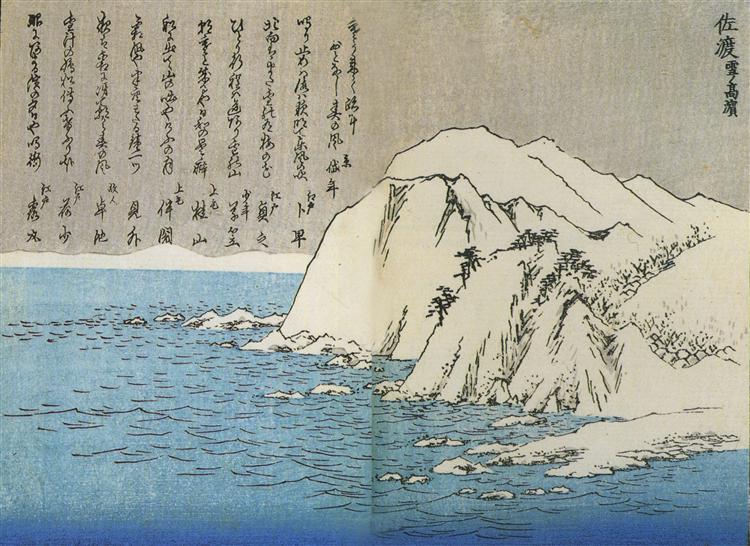Tanım
Utagawa Hiroshige’s “Mountains in the Snow” is a work that encapsulates the ephemeral beauty and majesty of the Japanese landscape, a recurring theme in the work of the artist, renowned for his ability to depict nature with unique sensitivity. Painted in a period when ukiyo-e woodblock printing was at its peak, this work is not only a testament to Hiroshige’s technical mastery, but also a reflection on the relationship between humans and their environment. The composition of the painting exudes a contemplative calm, with snow-capped mountains rising gracefully on the horizon.
The color palette used in “Mountains in the Snow” combines cool and soft tones that evoke winter: a variety of blues, grays and whites are intertwined with touches of green that suggest the persistent vegetation. This subtle use of color creates an almost ethereal effect, where the white of the snow shimmers under a diffused light, suggesting the freshness of the winter air. Hiroshige is known for his ability to capture the light and atmosphere of rural Japan, and in this work, he manages to capture the luminosity of the landscape in a moment of stillness and peace.
Although the painting focuses primarily on the depiction of the landscape, in the lower central part of the work there are figures that appear to be travelers or solitary people, hinting at the human presence in this vast natural expanse. These characters, although small and almost insignificant against the majestic immensity of the mountains, are situated in an environment that suggests movement and activity. They are a reminder of the human journey and its vulnerability before the grandeur of nature, themes that often resonate in Hiroshige's work.
In terms of technique, Hiroshige is noted for his use of woodblock printing, which allows for the presentation of fine details and the capture of subtle textures. “Mountains in the Snow” is a clear example of his mastery of this discipline, displaying an elegant simplicity that does not sacrifice the complexity of the visual experience. The contours of the mountains are meticulously defined, while the shapes of the snow flow with a softness that invites the viewer to lose themselves in contemplation of the landscape.
The work belongs to the ukiyo-e tradition, which was concerned with depicting "images of the floating world," and in this sense, "Mountains in the Snow" can be seen as a reflection on the transience of natural beauty. Hiroshige, as a master of this artistic movement, knew how to capture the essence of a moment in nature that is both a visual pleasure and a symbol of the transience of life and the resilience of the landscape to the passage of time.
In conclusion, “Mountains in the Snow” is not only a testament to Utagawa Hiroshige’s mastery of landscape painting, but is also a profound introspection on the connection between human and nature. Its meticulously balanced composition, delicate palette, and subtle inclusion of figures evoke a rich narrative about the human experience in the vast and sublime natural world. Hiroshige, through this work, remains a central figure in the history of Japanese art and, more broadly, in the history of global art, where his influence endures and continues to resonate with new audiences.
KUADROS ©, a famous painting on your wall.
Hand-made oil painting reproductions, with the quality of professional artists and the distinctive seal of KUADROS ©.
Painting reproduction service with satisfaction guarantee. If you are not completely satisfied with the replica of your painting, we will refund 100% of your money.

